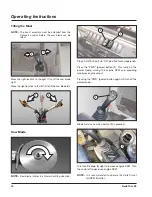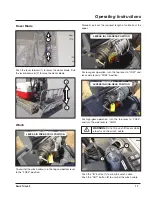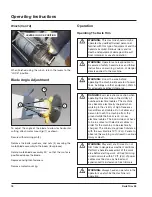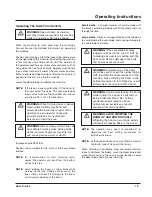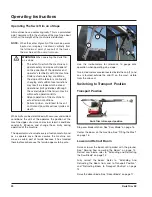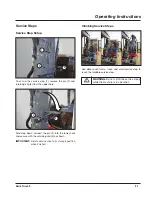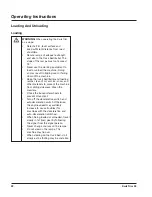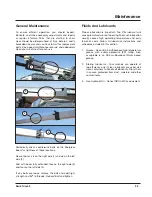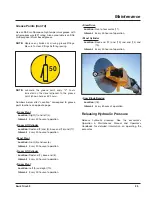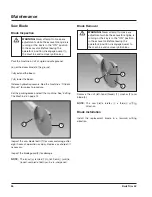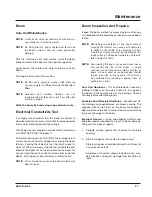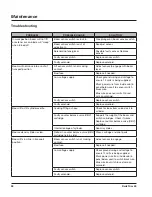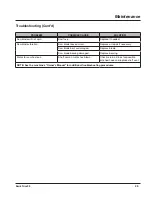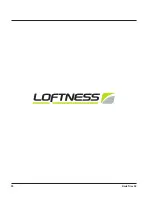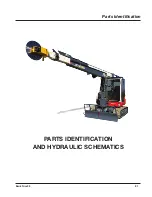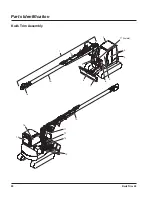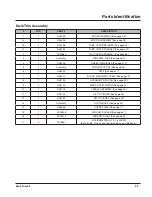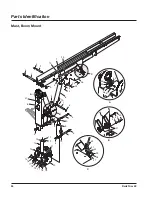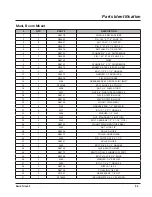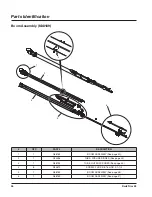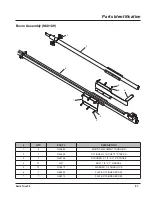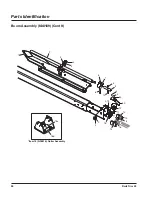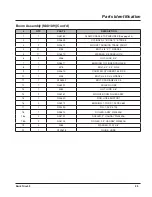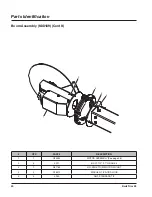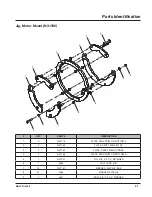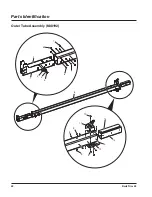
27
Kwik Trim 53
Maintenance
Boom
Care And Maintenance
NOTE:
A dirty boom does not shed rain as well and can
cause failure of di-electrical tests.
NOTE:
Do Not perform a boom di-electrical test while
the boom is wet as this can cause permanent
damage.
Park the machine on flat level surface, lower the dozer
blade and extend the boom to the operation position.
Lower boom fully to allow the water to drain out of the
boom.
Turn engine off and exit the machine.
NOTE:
Do Not use a pressure washer. High pressure
can cause water to diffuse through the fiberglass
fibers.
NOTE:
Abrasives and solvents cleaners are not
recommended as they can scratch or soften the
surface coatings.
Wash the boom by hand using soap and water only.
Electrical Conductivity Test
It is highly recommended that the boom be tested to
electrical conductivity every six months to insure operator
safety when working around high voltage.
This di-electric test should be conducted in accordance
with ANSI A92.2-2001 Category C.
Di-electric testing at over 1mA (1000 micro-amps) return
current can cause harm to the boom by causing the boom
to burn. If during the di-electric test, the return current is
close to 1000 micro-amps, stop the test immediately and
examine the boom for hot spots. Examine the boom for
any contamination such as dirt, moisture, sticks and other
debris. Let the boom cool and remove contamination.
NOTE:
Dirt or moisture can cause the boom to be burnt
beyond repair.
Boom Inspection And Repairs
Inspect the boom surface for cracks due to weather, age
or improper paint preparations as these can cause boom
failure.
NOTE:
Refinishing the exterior of the boom without
masking the interior can cause paint overspray
to settle on the inside. This overspray will trap
moisture and prevent water from beading on this
rough surface. The trapped moisture can lead to
failed di-electric tests.
NOTE:
Over loading the boom can cause stress cracks
and shorten the life of the boom. A single
overload can shorten service life by months or
years. A boom used as recommended should
remain in service for many years. A boom may
be overloaded by jamming it against trees or
putting it in a bind.
Cuts And Abrasions -
Cut and abrasions caused by
rubbing the boom on the side of trees etc. can weaken
the boom in the specific area of the damage. Consult
Loftness before attempting repair.
Sunshine And Ultraviolet Radiation -
Sunlight and UV
can damage an unpainted area of a boom causing. The
exposed area to look fuzzy as the fibers are exposed.
Repair surface scratches to seal out the sun and moisture
to prevent damage to the boom.
Improper Repairs -
Using substandard material and
improper repair procedures can result in boom damage.
There are two types of repairs:
1. Periodic surface repairs that involves the outside
coating.
2. Structural repairs that involve the boom itself.
Structural repairs should be referred to Loftness for
a case by case study.
Examples of structural repairs include cracks, cuts,
delamination and impact damage from tree limbs or
tools.
Summary of Contents for Kwik Trim 53
Page 2: ......
Page 4: ......
Page 5: ......
Page 6: ......
Page 7: ......
Page 8: ......
Page 12: ...Kwik Trim 53 ...
Page 18: ...6 Kwik Trim 53 ...
Page 24: ...12 Kwik Trim 53 ...
Page 42: ...30 Kwik Trim 53 ...
Page 43: ...31 Kwik Trim 53 PARTS IDENTIFICATION AND HYDRAULIC SCHEMATICS Parts Identification ...
Page 75: ...63 Kwik Trim 53 This page intentionally left blank Parts Identification ...
Page 93: ......




